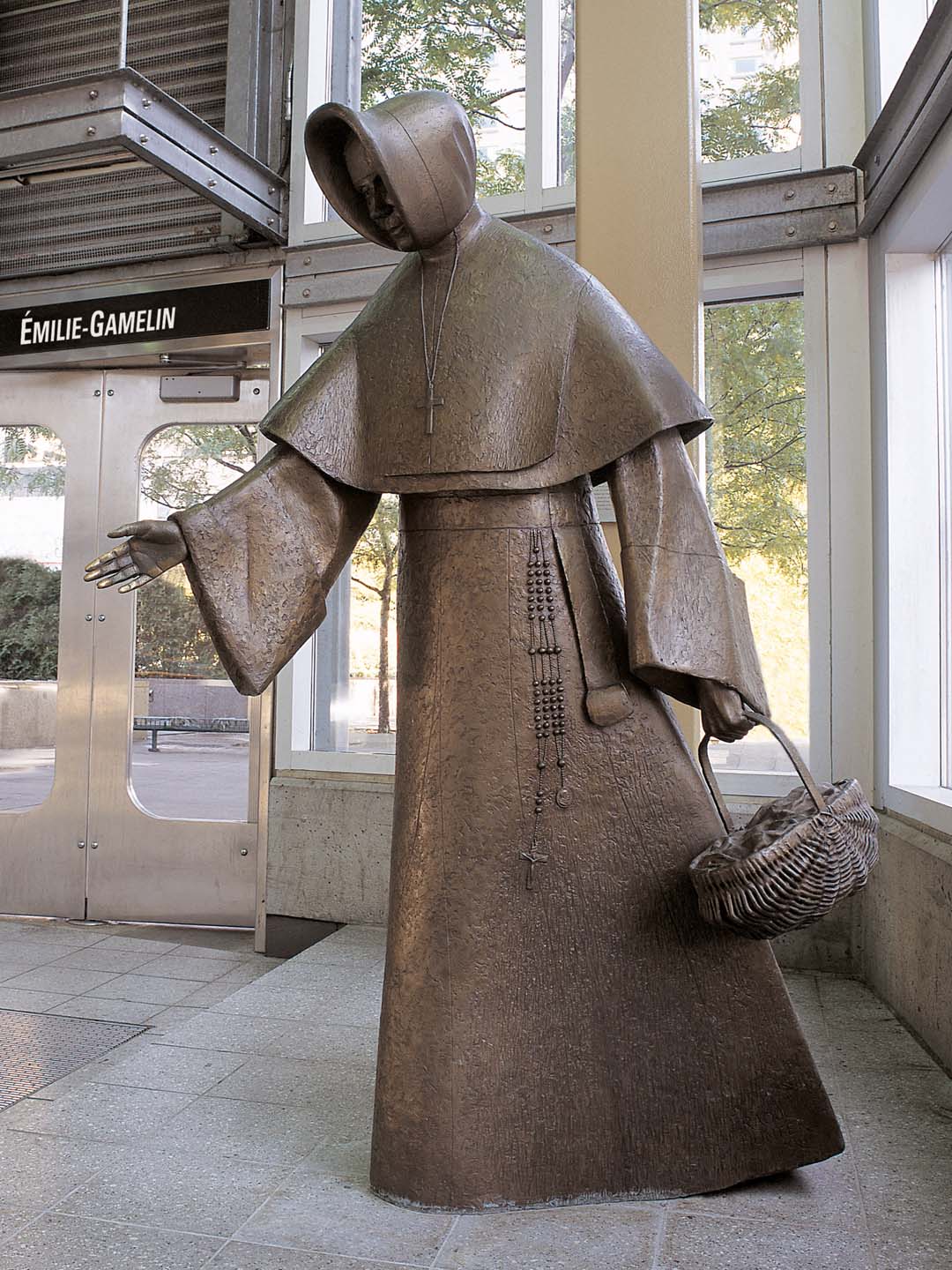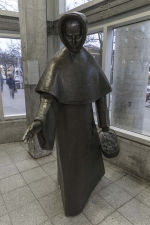Raoul Hunter
Monument à Émilie Gamelin
1999
Presentation of the artwork
The statue of Mother Émilie Gamelin is a faithful representation of the nun. It stands in the pavilion of the Berri-UQAM Metro station, in the square that bears her name. The artist Raoul Hunter was inspired by the only known authentic portrait of Mother Gamelin, painted in 1843 by Vital Desrochers and conserved in the motherhouse of the Sisters of Providence community in Montréal. Hunter’s full-round sculpture presents her dressed in her community’s habit, in action, carrying on her arm a basket of foodstuffs destined to relieve the hunger and misery of the forgotten of her time. The accentuated movement of her step recalls her great energy and generosity. Mother Gamelin is not portrayed on an elevated base; rather, she is on the same level as passersby. Her smile testifies to her openness and sympathy. The statute symbolizes the contribution made by this exemplary and pious woman to Montréal in her time and today. This work commemorates the bicentenary of her birth (19 February 1800).“I wanted to make as faithful as possible an image so that everyone could remember the features and the expression of this woman, who was directly concerned with the misery of her times.”– Raoul Hunter
Associated events
Born on 19 February 1800 in Tavernier, Mother Gamelin, as Émilie Tavernier was known, was the youngest in a family of 15 children. In 1823, she married Jean-Baptiste Gamelin, but he died four years later. A woman of action and compassion, in 1841, she founded Les Filles de la Charité, servantes des pauvres, which was later renamed Les Sœurs de la Providence. Mother Gamelin was particularly active in a number of refuges that she opened on Rue Sainte-Catherine between 1827 and 1843. In 1843, she instituted a soup kitchen, which, perpetuating her legacy, distributed millions of bowls of soup to the hungry until 1962. She died of cholera on 23 September 1851. On 23 December 1993, she was proclaimed Venerable by Pope John Paul II, who then beatified her on 7 October 2001.
Raoul Hunter
Raoul Hunter, born in Saint-Cyrille-de-Lessard, graduated from the École des beaux-arts de Québec in 1953. A teacher and sculptor, he was also a caricaturist and editorialist at the Québec City daily Le Soleil. Most of his sculptures were commissions. His production was very diverse, including statues, monuments, busts, medals, and bas-reliefs. His artworks are found in various locations in North America: Québec, Ontario, Alberta, Massachusetts, Washington, Oregon, Alaska, and California.
Awards and honours
- Médaille du jubilé de la Reine Élizabeth ll, 2002
- Membre de l'Académie des Grands Québécois, 1998
- Membre de l'Ordre du Canada, 1989
- Prix de la culture de l'Institut canadien de Québec, 1989
- Médaille du centenaire du Canada, 1967
- Médaille du Lieutenant-Gouverneur, 1953
- Médaille du Lieutenant-Gouverneur, 1952
- prix de la caricature du Concours national du journalisme (National Newspaper Award), 1958
- prix de la caricature du Concours national du journalisme (National Newspaper Award), 1967
Presentation of the artwork
The statue of Mother Émilie Gamelin is a faithful representation of the nun. It stands in the pavilion of the Berri-UQAM Metro station, in the square that bears her name. The artist Raoul Hunter was inspired by the only known authentic portrait of Mother Gamelin, painted in 1843 by Vital Desrochers and conserved in the motherhouse of the Sisters of Providence community in Montréal. Hunter’s full-round sculpture presents her dressed in her community’s habit, in action, carrying on her arm a basket of foodstuffs destined to relieve the hunger and misery of the forgotten of her time. The accentuated movement of her step recalls her great energy and generosity. Mother Gamelin is not portrayed on an elevated base; rather, she is on the same level as passersby. Her smile testifies to her openness and sympathy. The statute symbolizes the contribution made by this exemplary and pious woman to Montréal in her time and today. This work commemorates the bicentenary of her birth (19 February 1800).“I wanted to make as faithful as possible an image so that everyone could remember the features and the expression of this woman, who was directly concerned with the misery of her times.”– Raoul Hunter
Associated events
Born on 19 February 1800 in Tavernier, Mother Gamelin, as Émilie Tavernier was known, was the youngest in a family of 15 children. In 1823, she married Jean-Baptiste Gamelin, but he died four years later. A woman of action and compassion, in 1841, she founded Les Filles de la Charité, servantes des pauvres, which was later renamed Les Sœurs de la Providence. Mother Gamelin was particularly active in a number of refuges that she opened on Rue Sainte-Catherine between 1827 and 1843. In 1843, she instituted a soup kitchen, which, perpetuating her legacy, distributed millions of bowls of soup to the hungry until 1962. She died of cholera on 23 September 1851. On 23 December 1993, she was proclaimed Venerable by Pope John Paul II, who then beatified her on 7 October 2001.
Raoul Hunter
Raoul Hunter, born in Saint-Cyrille-de-Lessard, graduated from the École des beaux-arts de Québec in 1953. A teacher and sculptor, he was also a caricaturist and editorialist at the Québec City daily Le Soleil. Most of his sculptures were commissions. His production was very diverse, including statues, monuments, busts, medals, and bas-reliefs. His artworks are found in various locations in North America: Québec, Ontario, Alberta, Massachusetts, Washington, Oregon, Alaska, and California.
Awards and honours
- Médaille du jubilé de la Reine Élizabeth ll, 2002
- Membre de l'Académie des Grands Québécois, 1998
- Membre de l'Ordre du Canada, 1989
- Prix de la culture de l'Institut canadien de Québec, 1989
- Médaille du centenaire du Canada, 1967
- Médaille du Lieutenant-Gouverneur, 1953
- Médaille du Lieutenant-Gouverneur, 1952
- prix de la caricature du Concours national du journalisme (National Newspaper Award), 1958
- prix de la caricature du Concours national du journalisme (National Newspaper Award), 1967






